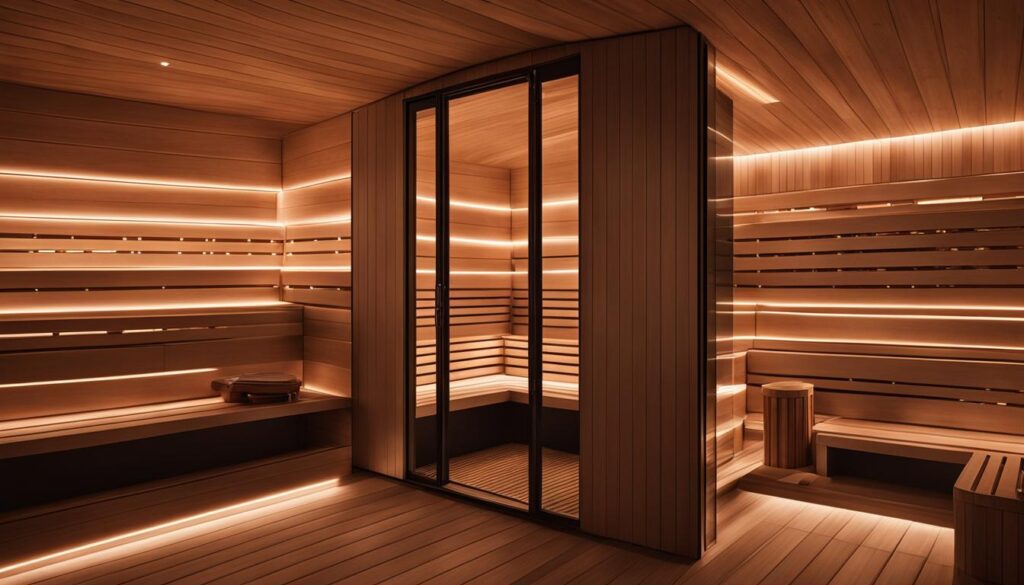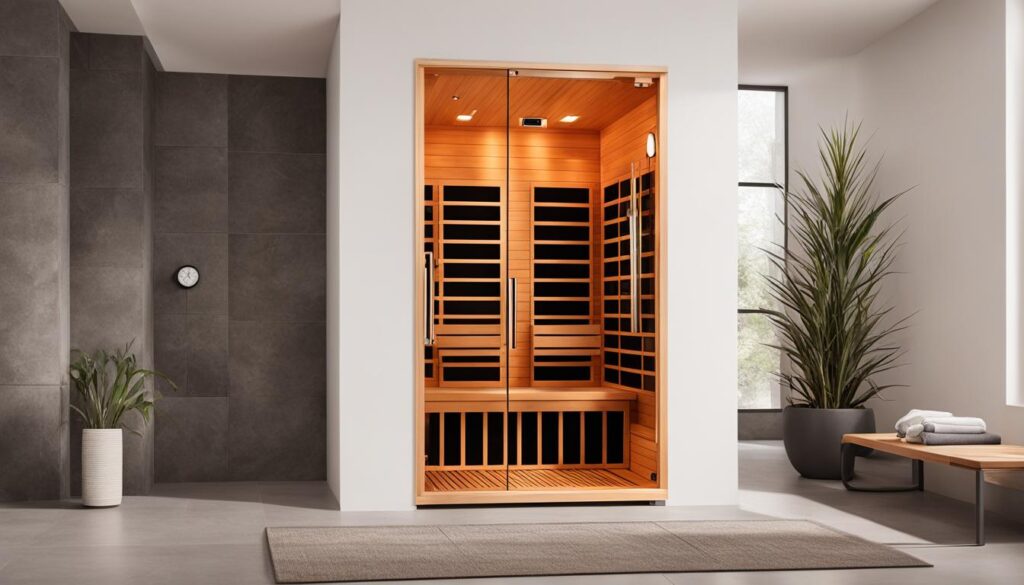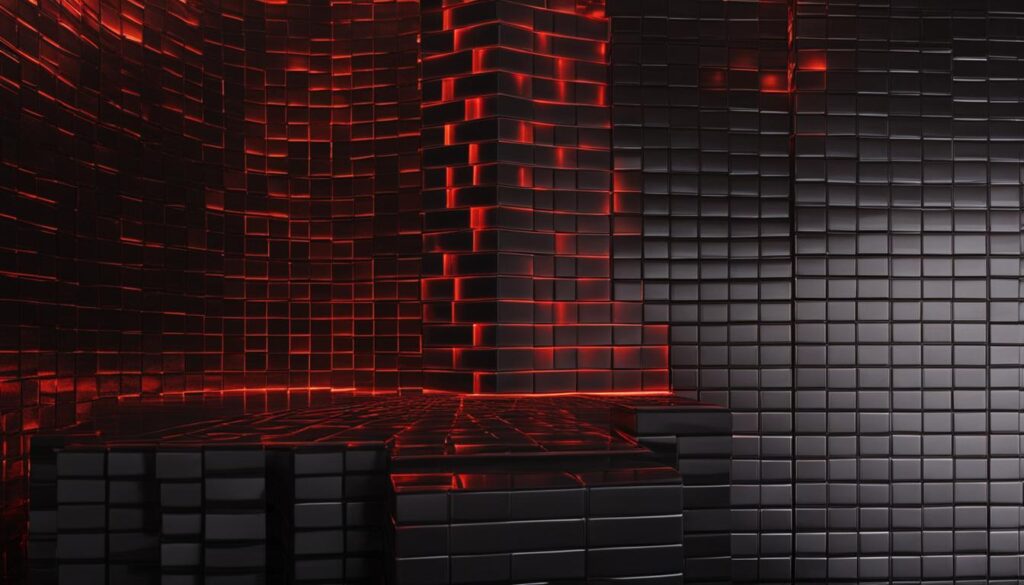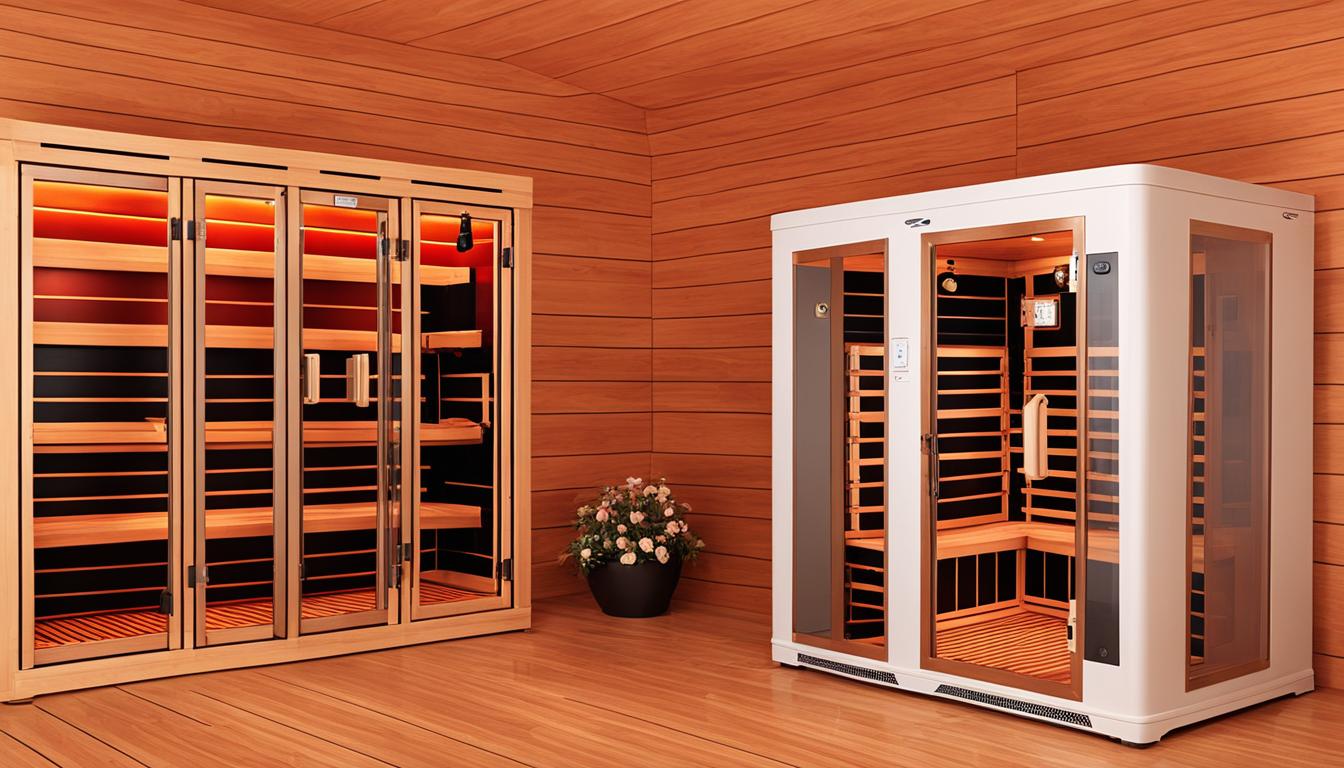Welcome to our comprehensive guide on carbon vs ceramic infrared saunas. If you’re in the market for an infrared sauna and looking to compare your options, you’ve come to the right place. In this article, we’ll delve into the differences between carbon and ceramic infrared saunas, helping you make an informed decision based on your needs and preferences.
Infrared saunas have gained popularity for their numerous health benefits, energy efficiency, and unique technology. However, understanding the nuances between carbon and ceramic infrared saunas can be confusing. But fear not, we’re here to unravel the mysteries for you.
By breaking down the technology, advantages, and drawbacks of each type, we’ll provide clarity on which sauna is the right fit for you. So, whether you’re after improved health and wellness or looking to make an energy-efficient investment, this guide will help you decide.
Key Takeaways:
- Carbon and ceramic infrared saunas have different heater technologies, resulting in distinct heating experiences.
- Consider your health goals and priorities to determine which type of sauna offers the most benefits for you.
- Energy efficiency and long-term cost savings should factor into your decision-making process.
- Each type of sauna has unique design elements and lifespans that may impact your choice.
- Ultimately, your decision should be based on a combination of factors, including health benefits, energy efficiency, cost analysis, safety features, and personal preferences.
The Basics of Infrared Sauna Technology
Infrared saunas are a popular choice for relaxation and therapeutic benefits. In this section, we will explore the fundamentals of infrared sauna technology and its key distinctions from traditional saunas. Additionally, we will delve into the crucial role that heaters play in infrared sauna operation.
Understanding Infrared Light and Heat
Infrared light is a form of electromagnetic radiation that lies beyond the visible spectrum. Unlike traditional saunas that heat the air around you, infrared saunas use infrared light to directly heat your body. This heat penetrates your skin more deeply, generating a host of therapeutic effects.
By harnessing the power of infrared light, infrared saunas can provide various health benefits. These include increased blood circulation, improved detoxification, pain relief, and enhanced relaxation.
How Infrared Saunas Differ from Traditional Saunas
While traditional saunas rely on high temperatures to heat the air, infrared saunas operate at lower temperatures between 120°F and 150°F (49°C and 66°C). This lower temperature range creates a more comfortable and tolerable environment, making infrared saunas accessible to a wider range of individuals.
Furthermore, traditional saunas typically produce a high level of humidity, which can be challenging for some individuals. In contrast, infrared saunas emit dry heat, allowing for a more enjoyable and customizable experience.
The Role of Heaters in Infrared Saunas
Heaters are the heart of an infrared sauna. They are responsible for converting electricity into infrared heat, which is emitted into the sauna cabin. There are two primary types of heaters used in infrared saunas: carbon fiber heaters and ceramic rod heaters.
Carbon fiber heaters are thin panels that contain multiple layers of conductive carbon. These heaters produce a gentle, long-wave infrared heat that is evenly distributed throughout the sauna. They have the advantage of emitting lower surface temperatures, making them safer and more comfortable to touch.
Ceramic rod heaters, on the other hand, utilize ceramic heating elements to generate infrared heat. These heaters can reach higher temperatures quickly, providing intense and focused heat. The ceramic material’s response to infrared waves allows for efficient heat production and delivery.
Delving into Carbon Infrared Saunas
In this section, we will dive deeper into carbon infrared saunas and explore the technology behind them. Carbon infrared saunas are known for their efficiency and effectiveness in providing a relaxing and therapeutic sauna experience.
What Are Carbon Fiber Heaters?
Carbon infrared saunas are equipped with carbon fiber heaters that are designed to emit infrared heat. These heaters are made from thin carbon panels that are evenly distributed throughout the sauna.
The Advantages of Lower Surface Temperature
One of the main advantages of carbon fiber heaters is their lower surface temperature compared to other heater types. This lower surface temperature enhances user comfort and safety during sauna sessions.
With lower surface temperatures, carbon infrared saunas allow for a more relaxed and enjoyable experience. Users can comfortably lean against the heaters without the risk of discomfort or burns.
Uniform Heat Distribution and Large Surface Areas
The unique design of carbon fiber heaters ensures uniform heat distribution across large surface areas. This means that the heat is evenly spread throughout the sauna, offering consistent warmth and maximizing the benefits of the infrared therapy.
Unlike other heater types, carbon fiber heaters cover a larger surface area of the sauna, resulting in a more comprehensive and effective heat therapy session. The uniform heat distribution allows users to experience the benefits of infrared heat across their entire body.
Overall, carbon infrared saunas with carbon fiber heaters provide a comfortable and therapeutic sauna experience, with lower surface temperatures and uniform heat distribution. These features make them a popular choice for those seeking the holistic benefits of infrared therapy.
Exploring Ceramic Infrared Saunas
In this section, we will delve into ceramic infrared saunas and explore the science behind their unique heating technology. Ceramic infrared saunas are known for their efficient and effective heat distribution, providing a comfortable and rejuvenating sauna experience.
The Science Behind Ceramic Rod Heaters
Ceramic infrared saunas utilize ceramic rod heaters as their heating source. These heaters are designed with ceramic material that has excellent thermal conductivity, allowing for efficient heat transfer. When electricity passes through the ceramic rods, they emit infrared waves that penetrate the body, promoting various health benefits.
How Higher Temperatures Influence Sauna Experience
One of the key advantages of ceramic infrared saunas is their ability to reach higher temperatures compared to other types of saunas. The higher temperatures in ceramic saunas enhance the sauna experience by promoting deeper sweating and detoxification. This allows for a more robust and effective sweat session, aiding in the removal of toxins from the body.
Ceramic Material’s Response to Infrared Waves
Ceramic materials have a unique response to infrared waves. They efficiently absorb and emit infrared heat, making them an ideal choice for sauna heaters. The ceramic material’s ability to retain and distribute heat evenly ensures that users experience consistent and comfortable warmth throughout their sauna session. This even heat distribution helps prevent any cold spots, allowing for a more enjoyable and therapeutic experience.
Carbon vs Ceramic Infrared Sauna: Energy Efficiency Compared
When considering the benefits of carbon and ceramic infrared saunas, energy efficiency plays a crucial role. By understanding how each type of heater utilizes energy, you can make an informed decision that not only promotes a greener lifestyle but also saves on long-term costs.
Carbon infrared saunas, equipped with carbon fiber heaters, have gained popularity due to their energy-efficient design. These heaters maintain a lower surface temperature while delivering uniform heat distribution across large surface areas. This allows for effective heat absorption by the body while minimizing energy consumption.
On the other hand, ceramic infrared saunas rely on ceramic rod heaters that can withstand higher temperatures. Although ceramic heaters may consume slightly more energy to achieve the desired sauna experience, their ability to reach higher temperatures quickly can reduce warm-up time and energy wastage.
When choosing between carbon and ceramic infrared saunas, consider your energy efficiency preferences and priorities. If you prioritize lower energy consumption and a gentle sauna experience, carbon saunas may be your ideal choice. However, if quick warm-up times and the ability to reach higher temperatures are important to you, ceramic saunas may be more suitable.
“Choosing an energy-efficient sauna not only benefits the environment but also your wallet in the long run.”
To give you a better idea of the energy efficiency comparison, take a look at the table below:
| Carbon Infrared Sauna | Ceramic Infrared Sauna | |
|---|---|---|
| Energy Utilization | Efficient utilization of energy due to lower surface temperature | Higher energy utilization due to higher temperature capabilities |
| Warm-up Time | Slightly longer warm-up time | Quick warm-up time due to higher temperature capabilities |
| Long-term Cost Savings | Potential for energy cost savings due to lower energy consumption | Potential for energy cost savings due to reduced warm-up time |
Remember, energy efficiency is just one factor to consider when choosing an infrared sauna. Take into account your specific needs, preferences, and budget to make the best decision that aligns with your overall sauna experience goals.

Comparing Health Benefits of Carbon and Ceramic Heaters
Infrared saunas offer a range of health benefits, and understanding the specific advantages of carbon and ceramic heaters can help you make an informed decision about which type of sauna is best suited to your needs.
Detoxification and Core Body Temperature
Both carbon and ceramic heaters contribute to the detoxification process by stimulating sweat production, which assists in eliminating toxins from the body. Sweating also helps to increase blood circulation, promoting healthier skin and improved overall well-being.
When it comes to core body temperature, carbon heaters are known for providing a gentle and gradual increase in heat. This allows users to experience a deep sweat without feeling overwhelmed by excessive heat. On the other hand, ceramic heaters generate intense heat, leading to a more rapid increase in core body temperature. This may be preferred by individuals who are seeking a more intense sauna experience.
Pain Relief and Muscle Relaxation
Both carbon and ceramic heaters have been shown to provide pain relief and promote muscle relaxation. Infrared heat penetrates deep into the muscles, helping to alleviate pain caused by inflammation, arthritis, and muscle tension.
Carbon heaters, with their lower surface temperature, are often preferred by individuals seeking targeted pain relief. The gentle heat penetrates the muscles, helping to soothe aches and pains. Ceramic heaters, with their higher temperatures, can provide a more intense heat therapy experience, aiding in muscle relaxation and releasing tension.
To fully experience the health benefits of infrared saunas, it’s important to consider your specific health goals and preferences when choosing between carbon and ceramic heaters.
Analyzing the Warm-Up Time and Temperature Range
In this section, we will delve into two important factors to consider when comparing carbon and ceramic saunas: warm-up time and temperature range. These aspects play a crucial role in your overall sauna experience, determining how quickly the sauna reaches the desired temperature and the comfort level you can expect at different temperature settings.
The Impact of Heater Type on Warm-Up Speed
When it comes to warm-up time, the type of heater used in the sauna plays a significant role. Carbon saunas typically have a shorter warm-up time compared to ceramic saunas. This is because carbon fiber heaters are known for their fast heat distribution and ability to reach the desired temperature more quickly. If you prefer a sauna that warms up rapidly, a carbon sauna may be the ideal choice for you.
On the other hand, ceramic saunas may take a bit longer to warm up. Ceramic rod heaters have a slower heat distribution, which means it may take slightly more time for the sauna to reach the desired temperature. However, this slower warm-up time can also have its advantages, as some individuals find the gradual heating process to be more relaxing and enjoyable.
Comfort Level at Different Temperatures
The comfort level experienced at different temperatures can vary depending on the type of sauna heater. Carbon saunas are known for providing a gentle and even heat, which can create a more comfortable environment for extended sauna sessions. The lower surface temperature of carbon heaters contributes to a more enjoyable and soothing experience.
Ceramic saunas, on the other hand, can reach higher temperatures compared to carbon saunas. This higher temperature range may appeal to individuals who prefer a more intense sauna experience or those looking for deeper heat penetration. However, it’s important to note that the high temperatures may not be as suitable for everyone, and it’s essential to listen to your body and choose a temperature that feels comfortable and safe for you.

Overall, when considering warm-up time and temperature range, it’s essential to assess your personal preferences and comfort level. Whether you opt for a carbon or ceramic sauna, both types offer unique benefits that can contribute to a fulfilling sauna experience.
Discussing Safety: Electromagnetic Fields (EMFs) in Focus
Infrared saunas are renowned for their many health benefits, but it’s important to also consider the safety aspects when choosing between carbon and ceramic heaters. One safety concern that often arises is the presence of electromagnetic fields (EMFs) and their potential effects on our well-being.
EMFs are invisible fields of energy produced by electrical devices, including infrared saunas. While there is ongoing debate about the potential health risks associated with EMFs, it is crucial to understand the differences between carbon and ceramic infrared saunas in terms of EMF levels.
Carbon infrared saunas typically emit lower levels of EMFs compared to ceramic saunas. This is because carbon heaters are designed to distribute heat evenly across a larger surface area, resulting in reduced EMF exposure. On the other hand, ceramic saunas may produce slightly higher EMF levels due to the nature of the ceramic rod heater technology.
When it comes to safety, it’s essential to consider individual sensitivities and take necessary precautions. If you have concerns about EMF exposure, it is recommended to consult with a healthcare professional and consider opting for a carbon infrared sauna, which generally has lower EMF levels.
It’s worth noting that most infrared saunas adhere to safety standards and regulations, ensuring that EMF levels are within acceptable limits. However, if you have specific concerns regarding EMFs, conducting thorough research, and choosing a sauna with lower EMF emissions can provide peace of mind.
Design and Longevity: Carbon Fiber Panels vs. Traditional Ceramic Heaters
When it comes to infrared saunas, the design and longevity of the heating elements play a crucial role in the overall performance and durability of the unit. In this section, we will compare the aesthetic appeal and lifespan of carbon fiber panels and traditional ceramic heaters, shedding light on their respective strengths.
In terms of design, carbon fiber panels offer a sleek and modern appearance that effortlessly blends into any home or wellness space. With their slim profile and even surface, carbon fiber panels create a visually appealing sauna experience that exudes contemporary elegance. On the other hand, traditional ceramic heaters have a more classic and rustic look, which some individuals prefer for a traditional sauna ambiance.

When it comes to longevity, carbon fiber panels have an edge. The carbon fibers used in these panels are highly durable and resistant to wear and tear. They are designed to withstand the extreme temperatures and conditions within an infrared sauna, ensuring a longer lifespan compared to traditional ceramic heaters. Ceramic heaters, although robust, may be more prone to cracking or breaking over time.
Ultimately, the choice between carbon fiber panels and traditional ceramic heaters depends on your personal preferences and desired aesthetic. While carbon fiber panels offer a sleek and contemporary design with exceptional longevity, traditional ceramic heaters provide a more rustic and traditional look. Consider your aesthetic preferences along with the durability factor when selecting the heating elements for your infrared sauna.
Cost Analysis: Upfront Investment and Long-Term Savings
In this section, we will conduct a comprehensive cost analysis of carbon and ceramic infrared saunas. Understanding the upfront investment required for each type of sauna and the potential long-term savings can help you make an informed decision.
When considering the upfront investment, it’s essential to evaluate the initial cost of purchasing and installing the sauna. Carbon infrared saunas generally have a higher upfront cost compared to ceramic saunas due to the advanced carbon fiber technology used in their heaters. However, the specific pricing may vary depending on the brand, size, and additional features of the sauna.
On the other hand, ceramic infrared saunas tend to have a more affordable upfront investment. Ceramic heaters are made from durable ceramic rods, which are relatively cost-effective to manufacture. This affordability makes ceramic saunas a popular choice for individuals on a budget.
While carbon saunas may require a larger upfront investment, they offer potential long-term savings in terms of maintenance, energy efficiency, and durability. Carbon heaters have a longer lifespan compared to ceramic heaters, reducing the need for frequent replacements. Additionally, carbon saunas are known for their energy efficiency, which can lead to significant savings in your electricity bills over time.
It’s important to weigh the upfront cost against the long-term savings when deciding between carbon and ceramic infrared saunas. Consider your budget, energy consumption, and desired sauna lifespan to determine which option offers the most cost-effective solution for your needs.
Understanding Cold Spots and Even Heat Distribution
One of the key considerations when choosing an infrared sauna is ensuring an even heat distribution throughout the entire space. Cold spots can significantly diminish the sauna experience as they create areas with lower temperatures and reduced therapeutic benefits. Both carbon and ceramic heaters offer solutions to combat cold spots and provide consistent heat, albeit in different ways.
Carbon infrared saunas utilize carbon fiber heaters, which are designed to emit infrared heat uniformly across a larger surface area. This ensures that heat is distributed evenly throughout the sauna, eliminating cold spots and creating a more enjoyable and effective sauna session. The lower surface temperature of carbon heaters also enhances user comfort and safety.
On the other hand, ceramic infrared saunas employ ceramic rod heaters. These heaters are known for their ability to reach higher temperatures quickly, contributing to the overall warmth of the sauna. While ceramic heaters can provide intense heat, they may require additional care to ensure even heat distribution and prevent cold spots.
Now let’s take a closer look at the differences between carbon and ceramic heaters in terms of their ability to eliminate cold spots and provide consistent heat.
Carbon infrared saunas utilize carbon fiber heaters, which emit infrared heat uniformly across a larger surface area, ensuring consistent heat distribution and eliminating cold spots. Ceramic infrared saunas, on the other hand, rely on ceramic rod heaters, which provide intense heat but require careful attention to prevent cold spots and maintain even heat.
To visualize the differences in heat distribution, take a look at the thermal image below.
As you can see, the carbon infrared sauna displays a more even heat distribution throughout the sauna, with minimal variations in temperature. On the other hand, the ceramic infrared sauna exhibits slightly uneven heat patterns, with slightly cooler areas near the corners. While these temperature variations may not significantly impact the overall sauna experience, it’s important to consider your preference for heat consistency when choosing between carbon and ceramic heaters.
| Carbon Infrared Sauna | Ceramic Infrared Sauna | |
|---|---|---|
| Heat Distribution | Even and consistent | Slightly uneven, with potential for cold spots in corners |
| Comfort and Safety | Lower surface temperature, enhanced user comfort | Higher temperatures, requires careful attention to prevent cold spots |
Ultimately, the choice between carbon and ceramic infrared saunas depends on your personal preferences and priorities. If you prioritize even heat distribution and a comfortable sauna experience, a carbon infrared sauna may be the ideal choice. However, if you prefer intense and quick heat, and are willing to take extra care to minimize cold spots, a ceramic infrared sauna may better suit your needs.
Conclusion
In conclusion, the main differences between carbon and ceramic infrared saunas lie in their heating technology and performance. Carbon saunas utilize carbon fiber heaters, which offer a lower surface temperature, ensuring a comfortable and safe sauna experience. These heaters also provide uniform heat distribution across large surface areas, ensuring an even sauna session.
On the other hand, ceramic saunas use ceramic rod heaters that can reach higher temperatures, providing a more intense sauna experience. The unique properties of ceramic materials allow them to respond well to infrared waves, enhancing the therapeutic benefits of the sauna.
When choosing the right infrared sauna for your needs, several factors should be considered. If you prioritize comfort and safety, carbon saunas with their lower surface temperature and uniform heat distribution are an excellent choice. For those seeking a more intense sauna experience with higher temperatures, ceramic saunas are a suitable option.
Ultimately, the decision comes down to personal preference and desired sauna experience. Understanding the main differences between carbon and ceramic infrared saunas will help you make an informed choice that aligns with your specific needs.
FAQ
What is the difference between carbon and ceramic infrared saunas?
Carbon and ceramic infrared saunas differ in terms of their heating elements. Carbon saunas use carbon fiber heaters, which have a lower surface temperature and provide a more comfortable and evenly distributed heat. Ceramic saunas, on the other hand, utilize ceramic rod heaters, which can reach higher temperatures and have a different response to infrared waves.
Are there any health benefits to using carbon or ceramic infrared saunas?
Yes, both carbon and ceramic infrared saunas offer a range of health benefits. These include detoxification, pain relief, muscle relaxation, and the potential to increase core body temperature for deeper sweating and improved circulation.
Which type of sauna is more energy-efficient, carbon or ceramic?
Carbon saunas are generally considered to be more energy-efficient than ceramic saunas. The lower surface temperature of carbon heaters allows them to operate at lower temperatures while still providing effective heating. This results in reduced energy consumption and potential long-term cost savings.
How do carbon and ceramic infrared saunas differ in terms of warm-up time and temperature range?
Carbon saunas typically have a faster warm-up time compared to ceramic saunas due to their lower surface temperature. However, ceramic saunas can reach higher temperatures than carbon saunas, offering a wider temperature range for those who prefer higher heat levels.
Are there any safety concerns with carbon or ceramic infrared saunas?
One safety concern with infrared saunas is the presence of electromagnetic fields (EMFs). Carbon saunas are often designed to have lower EMF levels compared to ceramic saunas. It is important to consider EMF levels and choose a sauna that meets your safety preferences.
Do carbon or ceramic infrared saunas have a longer lifespan?
The lifespan of an infrared sauna can depend on various factors, including the quality of construction and maintenance. Carbon fiber panels in carbon saunas are known for their durability, while ceramic rod heaters in ceramic saunas are designed to withstand higher temperatures. Both types can provide a long-lasting sauna experience with proper care.
How much does a carbon or ceramic infrared sauna cost?
The cost of a carbon or ceramic infrared sauna can vary depending on the brand, size, features, and additional accessories. Generally, carbon saunas tend to be more affordable compared to ceramic saunas. However, it is important to consider the upfront investment as well as potential long-term savings in terms of energy efficiency and durability when making a purchase decision.
Do carbon or ceramic infrared saunas have issues with cold spots?
Carbon saunas are designed to provide even heat distribution with large surface areas, minimizing the occurrence of cold spots. Ceramic saunas, on the other hand, may have cold spots due to the nature of their ceramic rod heaters. However, proper placement and design of heaters can help in reducing cold spots in ceramic saunas.
How do I choose the right infrared sauna for my needs?
When choosing the right infrared sauna, consider factors such as your preferences for heating elements, desired temperature range, energy efficiency, safety considerations, budget, and longevity. It is also beneficial to try out saunas or consult with experts to determine which sauna type aligns best with your specific needs and preferences.
